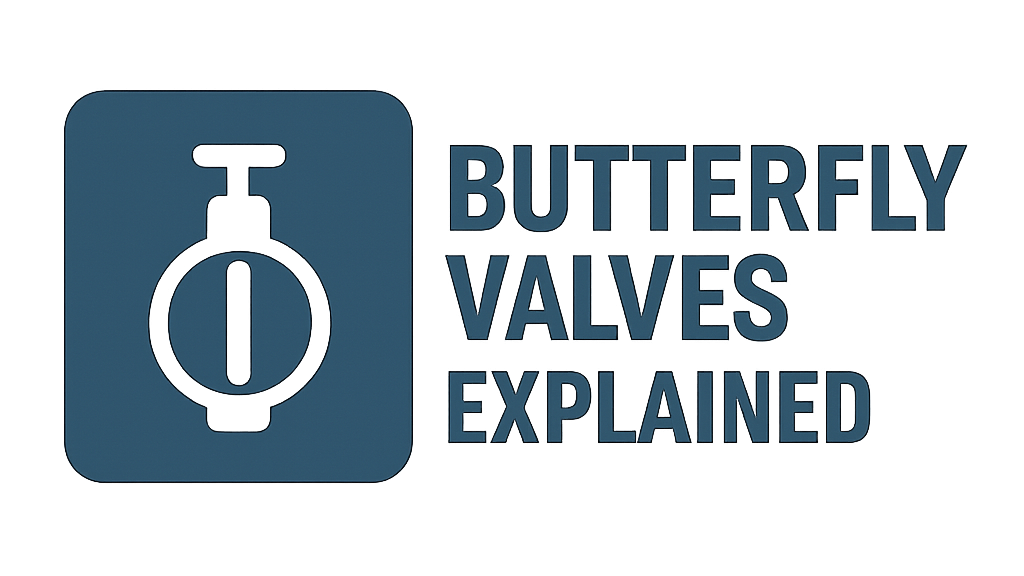Butterfly Valves Explained
Understanding Design, Operation, and Applications
Introduction to Butterfly Valves
Butterfly valves are a type of quarter-turn rotational motion valve used to stop, regulate, and start flow. They are characterized by a disc (the “butterfly”) which is mounted on a rod. When the valve is closed, the disc is turned so that it completely blocks off the passageway. When the valve is fully open, the disc is rotated a quarter turn so that it allows an almost unrestricted passage of the fluid. They are favored for their lightweight, compact design, lower cost, and quick operation.
Working Principle: Rotating Disc Control
The operation of a butterfly valve is simple and efficient:
- Quarter-Turn Operation: A 90-degree rotation of the handle or actuator moves the disc from fully open to fully closed, or vice versa.
- Disc Rotation: The disc is mounted on a central stem.
- When OPEN, the disc is parallel to the flow, offering minimal resistance.
- When CLOSED, the disc is perpendicular to the flow, sealing against a seat.
- Sealing: Achieved by the interference fit between the disc edge and a resilient or metal seat.
Butterfly valves can also be used for throttling, although their control characteristics are not as linear as globe valves.
OPEN
CLOSED
Key Components of a Butterfly Valve
Valve Body
The main pressure-containing structure, typically a short, cylindrical body. Common styles are wafer or lug type.
Disc (Butterfly)
The flow control element that rotates within the valve body to open or close the flow path.
Stem
Connects the actuator/handle to the disc, transmitting the rotational torque.
Seat
A resilient or metallic liner within the valve body that the disc seals against in the closed position.
Actuator/Handle
The mechanism for operating the valve (e.g., lever, gear operator, pneumatic/electric actuator).
Packing/Bearings
Seals around the stem to prevent leakage and bearings support the stem for smooth rotation.
Main Types of Butterfly Valves
Based on Disc Design/Offset:
Based on Body Construction:
Actuation Methods
Butterfly valves are versatile in their operation:
Manual (Lever)
Simple lever for quick quarter-turn operation, common for smaller sizes.
Manual (Gear Operator)
Reduces effort for larger valves or higher pressures.
Pneumatic Actuator
Uses compressed air for fast, automated operation.
Electric Actuator
Uses an electric motor for precise, automated control.
Advantages & Disadvantages
Advantages
- Lightweight and compact design, saving space and installation cost.
- Quick quarter-turn operation for fast shutoff.
- Relatively low cost, especially in larger sizes.
- Low pressure drop when fully open (compared to globe valves).
- Suitable for on/off and throttling services (especially offset designs).
- Available in very large sizes.
- Good range of material options for various fluids.
Disadvantages
- Disc is always in the flow path, causing some pressure drop even when open.
- Throttling characteristics are not as precise as globe or V-port ball valves.
- Seat wear can be an issue in abrasive or high-cycle applications (especially concentric).
- Susceptible to cavitation at high-velocity drops.
- Temperature limitations for soft-seated valves.
- Potential for leakage if not properly sealed, especially with metal seats in critical service.
Common Materials of Construction
Valve Body
- Cast Iron, Ductile Iron
- Carbon Steel (WCB)
- Stainless Steel (CF8, CF8M)
- Alloy Steels (e.g., Alloy 20, Duplex)
- Plastics (PVC, PP, PVDF)
Disc
- Stainless Steel (common)
- Ductile Iron (often coated/lined)
- Bronze, Aluminum Bronze
- Alloy Steels
- Plastic (encapsulated or solid)
Seat
- Resilient: EPDM, BUNA-N (Nitrile), Viton® (FKM), PTFE, RPTFE
- Metal: Stainless Steel, Stellite® (for triple offset or fire-safe)
Typical Applications
Butterfly valves are versatile and found in many sectors:
Key Selection Considerations
- Service Type: On/off, throttling, or isolation.
- Fluid Properties: Corrosiveness, abrasiveness, temperature, pressure.
- Flow Characteristics: Required Cv, acceptable pressure drop.
- Operating Conditions: Frequency of operation, velocity.
- Seat Material: Critical for temperature, chemical compatibility, and shutoff.
- Body Style: Wafer, lug, or flanged based on installation and maintenance needs.
- Offset Design: Concentric for general service, offset for higher performance/critical applications.
- Actuation Requirements: Manual or automated, speed, torque.
- Industry Standards: API 609, ASME B16.34, MSS SP-67/68.
- Cost & Maintenance: Butterfly valves are often cost-effective, especially in larger sizes.
Butterfly vs. Ball & Gate Valves
| Feature | Butterfly Valve | Ball Valve | Gate Valve |
|---|---|---|---|
| Operation | Quarter-turn (Rotary) | Quarter-turn (Rotary) | Multi-turn (Linear) |
| Primary Use | On/Off, Throttling | On/Off (Some Throttling) | On/Off (Isolation) |
| Pressure Drop | Moderate (Disc in flow) | Low (Full Port) | Very Low |
| Sealing | Good to Excellent | Excellent (Bubble-tight) | Good |
| Size/Weight | Lightweight, Compact | Compact | Can be bulky/heavy |
Efficient and Versatile Flow Control
Butterfly valves offer a compelling combination of simplicity, efficiency, and cost-effectiveness for a wide range of flow control applications. Their compact design and quick operation make them a popular choice in many industries. With advancements in design, such as double and triple offset types, their performance capabilities continue to expand, addressing even more demanding service conditions. Proper selection based on application requirements is key to leveraging their full potential.

